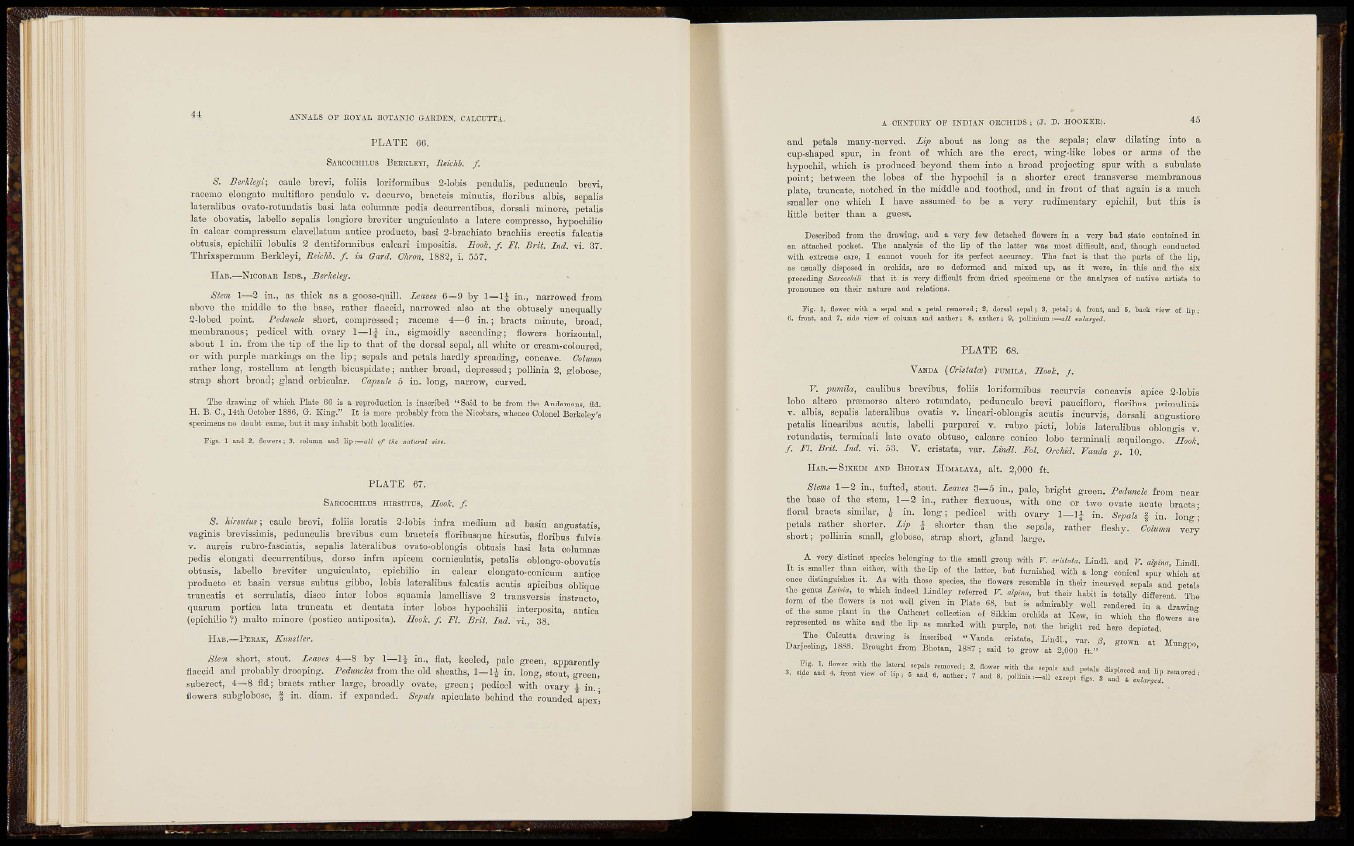
ANJfALS OP KOrAL BOTANIC GAEDEX, CALCUTTA.
P L A T E 66.
SARCOCHILUS BliEKLEYI, Reiclib. f.
S. Berkleiji-, caulo brevi, foliis loriformibiis 2-lobia peudulis, pedimculo brcvi,
raccmo elongato multifloro péndulo v. decurvo, bvacteis minutis, florlbus albis, sepalis
lateralibus orato-rotimdatis basi lata 001111111103 pedis decurrentibus, dorsali minore, petalis
late oboyatis, labello sepalis longiore breviter unguiculato a latere compvesso, hypocMlio
in calcar eompressum clavellatum anticc producto, basi 2-brachiato brachiis erectis faleatis
obtusis, epicbilii lobulis 2 dentiformibus calcari impositis. Ilook. f . Fl. Brit. Ind. vi. 37.
Thrixspermum Berkleyi, Reichh. f . in Gard. Citron. 1882, i. 557.
HAB.—•NICOBAR ISDS., Berkeley.
Stem 1—2 in., as thick as a goose-quill. Leaves 6—9 by 1—1J in., narrowed from
above the middle to the base, ratlier flaccid, narrowed also at the obtusely unequally
2-Iobed point. Peduncle short, compressed; raceme i—6 in.; bracts minute, broad,
membranous; pedicel with ovary 1—1^ in., sigmoidly ascending; flowers horizontal,
about 1 in. from the tip of the lip to that of the dorsal sepal, all white or cream-coloured,
or with purple markings on the lip; sepals and petals hai-dly spreading, concave. Column
rather long, rostellum at length bicuspidate; anther broad, depressed; pollinia 2, globose,
strap short broad; gland orbicular. Capside 5 in. long, narrow, curved.
The drawing of wMch Plate 66 ia a reproduction is inscribed "Said to be from tho Andomans, fld.
H. B. C., 14th October 1886, G. King." It is more probably from the Nicobars, whenee Colonel I
specimens no doubt came, but it may inhabit both localities.
Figi. 1 and 2, flowers; 3, column and lip :—all of the natural size.
P L A T E 67.
SARCOCHILUS Hook. f.
S. himttus-, caule brevi, foUis loratis 2-lobis infra medium ad basin augustatis,
vaginis brevissimis, pedunculis brevibus cum bracteis florihusque hirsutis, floribus fulvis
V. aureis rubro-fasciatis, sepalis lateralibus ovato-oblongis obtusis basi lata columns
pedis elongati decurrentibus, dorso infra apicem corniculatis, petalis oblongo-obovatis
obtusis, labello breviter unguiculato, epichilio in calcar elongato-conicum antice
producto et basin versus subtus gibbo, lobis lateralibus falcatis acutis apicibus oblique
truncatis et sorrulatis, disco inter lobos squainis lamellisve 2 transversis instructo
qnarum pertica lata truncata et dentata inter lobos hypochilii interposita, antica
(epichilio?) multo minore (postico antipositaj. Hook. f . Fl. Brit. Ind. yì., 38.
HAB.—PERAK, Kunstler.
Stern short, stout. Leaves 4—8 by 1—i n . , flat, keeled, pale green, apparently
flaccid and probably drooping. Peduncles from the old sheaths, 1 — i n . long, stout, green,
suberect, 4—8 fld; bracts rather large, broadly ovate, green; pedicel with ovary 1 ¡a
tìowers subglobose, | in. diam, if expanded. Sepals apiculato behind the rounded apox'
A CENTUHr OP INDIAN OECHIDS ; (J. D. HOOKER).
and petals many-nerved. Lip about as long as the sepals; claw dilating into a
cup-shaped spur, in front of which are the erect, wing-like lobes or arms of the
hypochil, which is produced beyond them into a broad projecting spur with a subulate
point; between the lobes of the hypochil is a shorter erect transverse membranous
plate, truncate, notched in the middle and toothed, and in front of that again is a much
smaller one which I have assumed to be a very rudimentary epichil, but tliis is
little better than a guess.
Described from the drawing, and a very few detached flowers in a very bad state contained in
an attached pocket. The analysis o£ the lip of the latter was most diiflcult, and, though conducted
with extreme caie, I cannot vouch for its perfect accuracy. The fact is that the parts of the lip,
as usually disposed in orchids, are so deformed and mixed up, as it were, in this and the six
preceding Sarcochili that it is very difBcult from dried specimens or the analyses of native artists to
pronounce on their nature and relations,
Fig. 1, flon-or with a sopal and a petal temovod; 2, dorsal sepal; 3, petal; 4, front, and 6, back Tisw of lip;
6, front, and 7, side view o£ column and antlier; 8, aotlier; 9, pollinium:—ti^i enlarged.
P L A T E 68.
VANDA {Cristatcn) PUJIILA, Hook. J.
V. piimüa, caulibus brevibus, foHis lorifoiinibus recurvis concavis apice 2-lobis
lobo altero prfemorso altero rotundato, pedunculo brevi paucifloro, floribus pnmulinis
V. albis, sepalis lateralibus ovatis V. lineari-obiongis acutis incurvis, dorsali anfustiore
petalis Imeatibus acutis, labelK purpm-oi T. I-ubro picti, lobis lateralibus oblongis T.
rotiindatis, toiminali lata orato obtnso, calcare conico lobo terminali ajquilongo. jTooi
/ . f i . Brit, Ind. TÌ. 53. V. cristata, var. Lmll. Fui. Orchùl, Vanda f . 10.
HAB.—SlKKDi AKD BHOT.yn HUIALAYA, alt. 2,000 ft.
Sims 1 - 2 in., tufted, stout. Zams 3-. Í in., pale, briglit green. Padunch from near
t h e baso of the stem, 1 - 2 in., rather flexnous, mth one or two ovate acute bracts;
iloi-al bracts similar, J in. long; pedicel with ovary 1—li in. Sefals | in lone •
petals rather shorter. Lif i shorter than the sepals, rather fleshy. yer^
s h o r t ; pollinia small, globose, strap short, gland largo.
A TBry aktinot species belonging to tlio small group vrith F. crliMn. Lindi, and F. oSjini Lindi
I l i3 mallet than either, «Ih the lip of the latter, but firrnieied with a long oonic.l .pnr i i e h at
once distinguishes i t A. with those species, the flower! resemble in tbeii inonrred sepals and petals
the genu, i . « . , to which indeed Lindl.y referi.ed F. «Ifim, but their habit is totally diSerent The
term of the flowers is not well given in Hal. 68, but is admirably well rendei^ in a drawing
of the same plant m the O.lheait coU.otion of Siliim orohid, at Kew, in which tb, flower. J .
represented a, white and the lip as marked with purple, not the bright red hero depicted.
The Calcutta drawing is inietibed "Vanda cristata, Lindi, var S .» >r
DarjeeKng, 1SS8. Brought from Bhctau, 1837; said to grow at 2,000 ft."